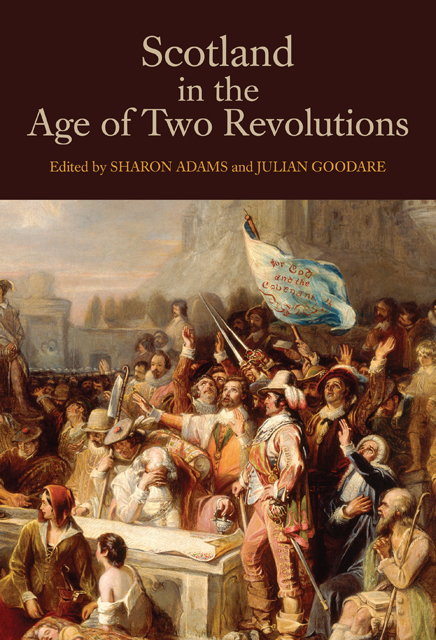Book contents
- Frontmatter
- Dedication
- Contents
- Figures and Tables
- List of Contributors
- Preface
- List of Abbreviations
- 1 Scotland and its Seventeenth-Century Revolutions
- 2 The Middle Shires Divided: Tensions at the Heart of Anglo-Scottish Union
- 3 The Western Highlands and Isles and Central Government, 1616–1645
- 4 The Scottish Bishops in Government, 1625–1638
- 5 The Scottish Revolution
- 6 In Search of the Scottish Republic
- 7 Highland Lawlessness and the Cromwellian Regime
- 8 The Worcester Veterans and the Restoration Regime in Scotland
- 9 The Political Thought of the Restoration Covenanters
- 10 Scottish State Oaths and the Revolution of 1688–1690
- 11 The Tribulations of Everyday Government in Williamite Scotland
- 12 The Company of Scotland and Scottish Politics, 1696–1701
- Chronology of Seventeenth-Century Scotland
- Further Reading
- Index
- Studies in Early Modern Cultural, Political and Social History
10 - Scottish State Oaths and the Revolution of 1688–1690
Published online by Cambridge University Press: 28 February 2023
- Frontmatter
- Dedication
- Contents
- Figures and Tables
- List of Contributors
- Preface
- List of Abbreviations
- 1 Scotland and its Seventeenth-Century Revolutions
- 2 The Middle Shires Divided: Tensions at the Heart of Anglo-Scottish Union
- 3 The Western Highlands and Isles and Central Government, 1616–1645
- 4 The Scottish Bishops in Government, 1625–1638
- 5 The Scottish Revolution
- 6 In Search of the Scottish Republic
- 7 Highland Lawlessness and the Cromwellian Regime
- 8 The Worcester Veterans and the Restoration Regime in Scotland
- 9 The Political Thought of the Restoration Covenanters
- 10 Scottish State Oaths and the Revolution of 1688–1690
- 11 The Tribulations of Everyday Government in Williamite Scotland
- 12 The Company of Scotland and Scottish Politics, 1696–1701
- Chronology of Seventeenth-Century Scotland
- Further Reading
- Index
- Studies in Early Modern Cultural, Political and Social History
Summary
How radical was the Scottish Revolution of 1688–90? Until the 1990s, historians saw the overthrow of James VII and the settling of the crown on William and Mary as the actions of a cautious political elite. In this interpretation, the Scots were ‘reluctant revolutionaries’. They produced few or no innovations in political thought, and justified their actions in the conservative terms of feudal law. Scholars depicted the Revolution settlement as a response to developments in England, and argued that the Claim of Right, a catalogue of the illegal practices of the former regime, was based on the English Bill of Rights. Questioning these assessments, recent historians have emphasised the significant constitutional and political changes brought by the settlement of 1689–90. The convention of estates’ decision that James VII had ‘forfaulted’ the throne was compatible with a radical view of the Revolution, in which the king’s deposition resembled that of his great-grandmother, Mary queen of Scots. The Claim of Right not only described the ways in which the crown in the Restoration period had ruled unlawfully, but also called for reforms, most notably the abolition of episcopacy in the Church. This demand, like the request for more frequent parliaments, was inspired by the achievements of the Covenanters after 1638, as much as by the Bill of Rights. Moreover, the Revolution did not lack political thinkers, and clergymen, lawyers and politicians gave fresh impetus to contractual theories of monarchy that had fallen from favour in the Restoration period.
I
This chapter investigates a largely overlooked aspect of revolutionary change: transformations in the use and character of state oaths. A state oath was a declaration devised by a legitimate political authority, to be sworn by particular people as a test of faith or loyalty, often in order to take on a political office. Contemporaries distinguished between promissory oaths, which contained promises to perform specified actions, and assertory oaths, which required the swearer to testify his or her agreement with a statement of fact or principle. The most important state oath was the oath of allegiance, a formal guarantee of loyalty to the monarch. This oath was sworn mainly by propertied men and office-holders, but the seventeenth century saw new state oaths imposed on a much wider range of people. Men and women at all social levels swore the National Covenant (1638) and the Solemn League and Covenant (1643).
- Type
- Chapter
- Information
- Scotland in the Age of Two Revolutions , pp. 173 - 192Publisher: Boydell & BrewerPrint publication year: 2014
- 1
- Cited by



